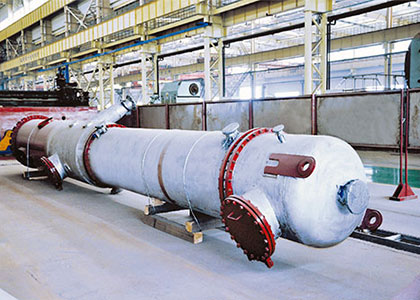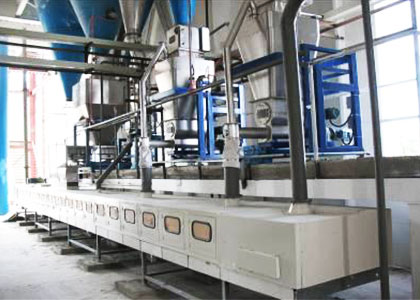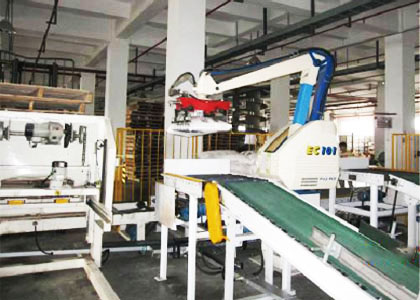Paper pulp is fibrous material based on plant fiber as raw material and processed by different methods. According to processing methods, it can be divided into mechanical pulp, chemical pulp and chemical-mechanical pulp. According to the fiber materials, it can also be divided into wood pulp, straw pulp, hemp pulp, reed pulp, bagasse pulp, bamboo pulp, rag pulp, etc. According to different purities, it can be also divided into refined pulp, bleached pulp, unbleached pulp, high yield pulp and semi-chemical pulp.
Paper pulp is more commonly used in the manufacture of paper and cardboard. In addition to the use of refined pulp for the manufacture of specialty papers, it is often used as a raw material for the production of cellulose derivatives such as cellulose esters and cellulose ethers. It is also used in the fields of man-made fibers, plastics, coatings, film, gunpowder and others. At present, wood resources of China cannot meet the growing needs of the pulp and paper pulp mill. In order to compensate for the lack of raw materials, a considerable amount of pulp is imported from abroad. Main importing countries include the United States, Canada and Brazil and so on.

Present Situation of Paper Pulp Mill
In China, there are more than 100 paper pulp mills. Most domestic paper-based mills have imported most of raw materials for special paper. In the medium and long term, the probability of rising price of papermaking is still high. The high international paper prices have had a subtle impact on domestic pulp mills. Under the pressure of imported raw material costs, the paper making companies with high self pulp making rates have some advantages in terms of cost control.
Global Trend of Pulp Market
At present, stable output and active trade are the main features of the world's pulp market. The increase in consumption of tissue paper worldwide is considered as a key growth point for toilet paper in the family part. For example, toilet paper, tissue paper and facial tissue. As a hygienic necessity, the demands for tissue paper in the coming years will boost the growth of the global pulp market. For example, fluff pulp has been widely used in products such as diapers, adult incontinence products, feminine hygiene products, pet mats and food absorbent pads, which has become an important growth point.
Depending on our information, global paper pulp production has reached 181 million tons in 2015, which is slightly less than 0.23% in 2014. North America, Europe and Asia are still mainly three regions with the largest pulp production. Their outputs are respectively 65.504 million tons (36.2% of global output), 45.588 million tons (25.2% of global output) and 39.71 million tons (21.9% of global production). Rapid growth happens in Latin America. Their pulp production has 25.376 million tons in 2015. It is an increase of 2.74%, accounting for 14% of global output. Latin America has become the fourth largest pulp production area.
From the view point of national, the largest pulp output of the top five countries making paper pulp are the United States, Brazil, Canada, China and Sweden, accounting for 61.2% of the world's total pulp output.
From the view point of the product category, the largest output of paper pulp is chemical wood pulp. Its production has reached 134 million tons, accounting for 74.31% of the total output. It is followed by mechanical wood pulp (25. 342 million tons, 14.01%), chemical-mechanical pulp (8.995 million tons, 4.97%) and other fiber pulps (12.145 million tons, 6.71%).
In 2015, the world's pulp trade has reached 53.823 million tons. Latin America is the largest net exporter of paper pulp with 14.998 million tons. Asia is the largest net importer with 21.92 million tons.

Brazil output is 10.615 million tons. It is unchanged from the same period of last year, accounting for 19.72% of the world's pulp exports. Canada output is 9.39 million tons. It is up to 3.76%, accounting for 17.45%. The United States output is 1.51%, accounting for 13.04%. Chile output is 4.67 million tons. It is unchanged from the same period of last year, accounting for 8.68%. And Indonesia output is 3.524 million tons, representing a year-on-year increase of 6.55%. They are top five exporters of making paper pulp in the world. The total amount of world pulp exporters has accounted for 65.43%. China import is 165.07 million tons. It is unchanged from the same period of last year, accounting for 31.21% of world pulp import. The United States is 5.233 million tons, accounting for 9.89%. Germany is 4.47 million tons, accounting for 8.45%. Italy is 3.49 million tons, accounting for 6.6%. South Korea is 2.276 million tons, accounting for 4.3%. They are top five import countries. Their demands have accounted for 60.45% of the total world pulp import.
The resource endowment and policy space of China have limited the development of the pulp production. Because of the relative lack of wood resources, making paper pulp is facing many restrictions. Compared with the world's major paper pulp mill, China is far below the world's major countries such as Finland, Russia, Brazil, Sweden, Indonesia, Canada and Chile in terms of overall forest coverage or per capita forest. There is an obvious resource ceiling of making paper pulp.
How to Deal with the Development of Pulp Market as a Paper Pulp Mill
As a paper pulp mill, especially small and medium-sized paper pulp mill, its paper pulper machine is more and more aging and cannot apply new technologies timely. The problems of environment, low output, low automation and high labor costs cannot be changed in time. If it cannot adopt new paper pulper machine and new technologies for strengthening management, it will be eliminated as backward production capacity. In view of the huge demand for paper pulp in China and the strong contrast between advanced paper pulper machine manufacture and huge demands, the customers both at home and abroad should consider re-investment or new construction in recent years so as to seize enormous pulp market opportunities from China.





